图示“方位介词”
- 格式:docx
- 大小:242.16 KB
- 文档页数:5
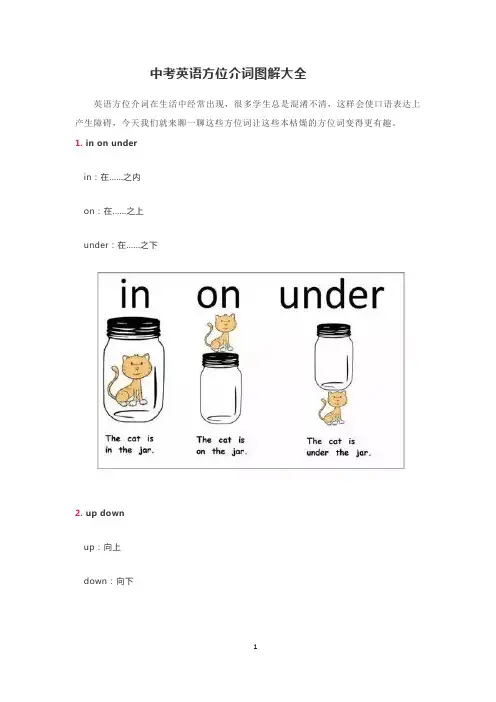
中考英语方位介词图解大全英语方位介词在生活中经常出现,很多学生总是混淆不清,这样会使口语表达上产生障碍,今天我们就来聊一聊这些方位词让这些本枯燥的方位词变得更有趣。
1. in on underin:在......之内on:在......之上under:在......之下2.up downup:向上down:向下3.beforebefore:在......之前04outside inside outside:在......外面inside:在......里面4. above belowabove:在.....上方below:在......下方5.by besideby、beside:在......旁边6. next tonext to:紧挨7. behindbehind:在......后面8.toto:到......去9.(a)round(a)round:围绕10 betweenbetween:在......之间(只两者)11. amongamong:在......之间(三者或三者以上)12.acrossacross:横过、越过13.throughthrough:穿过14. intointo:进入到......之内15.out ofout of:从......出来16.alongalong:沿着17. in front ofin front of:在…前面(某物的前方)18.left rightleft:左边right:右边。
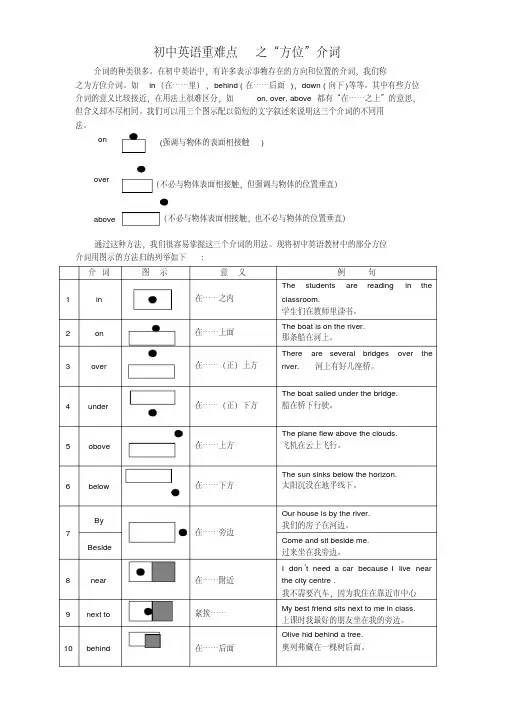
初中英语重难点之“方位”介词介词的种类很多。
在初中英语中,有许多表示事物存在的方向和位置的介词,我们称之为方位介词。
如in(在……里),behind (在……后面),down (向下)等等。
其中有些方位介词的意义比较接近,在用法上很难区分,如on, over, above 都有“在……之上”的意思,但含义却不尽相同。
我们可以用三个图示配以简短的文字叙述来说明这三个介词的不同用法。
onoverabove通过这种方法,我们很容易掌握这三个介词的用法。
现将初中英语教材中的部分方位介词用图示的方法归纳列举如下:介词图示意义例句1 in 在……之内The students are reading in the classroom.学生们在教师里读书。
2 on 在……上面The boat is on the river. 那条船在河上。
3 over 在……(正)上方There are several bridges over the river. 河上有好几座桥。
4 under 在……(正)下方The boat sailed under the bridge. 船在桥下行驶。
5 obove 在……上方The plane flew above the clouds. 飞机在云上飞行。
6 below 在……下方The sun sinks below the horizon. 太阳沉没在地平线下。
7By在……旁边Our house is by the river.我们的房子在河边。
BesideCome and sit beside me.过来坐在我旁边。
8 near 在……附近I don’t need a car because I live near the city centre .我不需要汽车,因为我住在靠近市中心9 next to 紧挨……My best friend sits next to me in class. 上课时我最好的朋友坐在我的旁边。
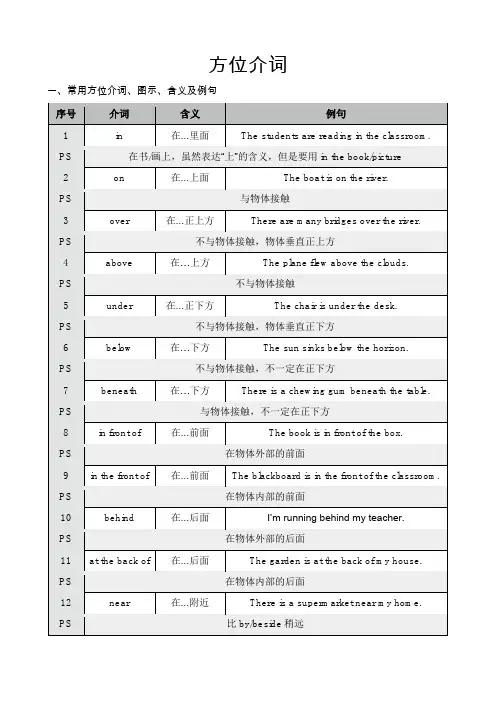
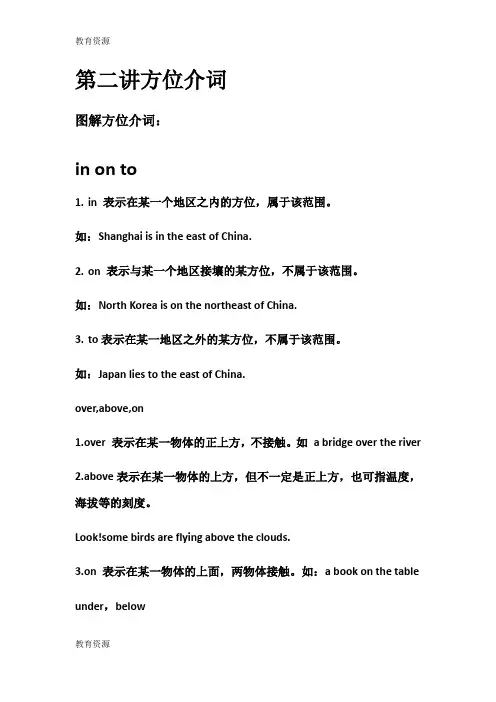
第二讲方位介词图解方位介词:in on to1.in 表示在某一个地区之内的方位,属于该范围。
如:Shanghai is in the east of China.2.on 表示与某一个地区接壤的某方位,不属于该范围。
如:North Korea is on the northeast of China.3.to表示在某一地区之外的某方位,不属于该范围。
如:Japan lies to the east of China.over,above,on1.over 表示在某一物体的正上方,不接触。
如a bridge over the river2.above表示在某一物体的上方,但不一定是正上方,也可指温度,海拔等的刻度。
Look!some birds are flying above the clouds.3.on 表示在某一物体的上面,两物体接触。
如:a book on the table under,below1.under表示在某一物体的正下方,与over相对。
如a box under the table2.below表示在某一物体的下方,但不一定是正下方。
也可指温度,海拔等的刻度。
如:Your temperature is below 37C.in front of ,in the front of ,before ,behind ,opposite1.in front of表示“在...之前”在范围之外。
如There is a tree in front of my house.2.in the front of 表示“在..之前”在范围之内。
如There is a blackboard in the front of the classroom.3.before表示“在..之前”在范围之外,所表示的位置关系和in front of 通用,但是before更多的是用来指时间。
4.behind表示“在...之后”与in front of 和before相对。
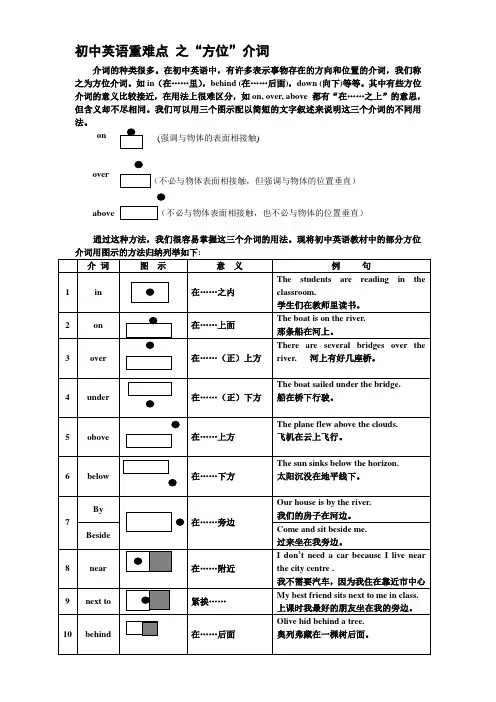
初中英语重难点之“方位”介词介词的种类很多。
在初中英语中,有许多表示事物存在的方向和位置的介词,我们称之为方位介词。
如in(在……里),behind (在……后面),down (向下)等等。
其中有些方位介词的意义比较接近,在用法上很难区分,如on, over, above 都有“在……之上”的意思,但含义却不尽相同。
我们可以用三个图示配以简短的文字叙述来说明这三个介词的不同用法。
on overabove通过这种方法,我们很容易掌握这三个介词的用法。
现将初中英语教材中的部分方位(强调与物体的表面相接触)几组方位介词的区别方位介词in, on, to的区别:1.in表示"在……范围内”,还表示“在…之中” Chongqing lies in the southwest of China.2.on表示“与……毗邻,接壤”Canada lies on the north of America.3.to表示方位,不接壤Hunan lies to the east of Zhejiang.表示地点位置的介词:1.at, in, on, toat 用于小地方,at school, at homeIn 用于大地方,in Beijing, in ChinaOn在……上面,on the map, on the tableTo到……To Chongqing2.Above, over, onAbove在……上方(高过另一个物体,不强调垂直)The airplane flies above that tall building.(不在正上方)over在……上方(垂直上方)The bridge spans over the river.On在……上面(物体表面有接触)There's some water on the floor, so you should be careful.3.Below, under在……下面Under在……下(正下方)The cat lies under the chair.(正下方)Below在……下(不一定是正下方)The cat lies under the chair.(不是正下方)4.in front of, in the front of 在……的前面in front of 在外部的前面,两个东西是独立的,相反的是behind The building is in front of the hospital.The building is behind the hospital.In the front of在内部的前面,属于其中的一部分,相反的是at the back ofThe girl stands in the front of the classroom.The girl stands at the back of the classroom.5.Beside, near, byBeside在旁边Near在附近By在附近,非常靠近常见方位介词短语(一)、由介词in构成的方位介词短语1、in the front 在前面2、in the front row 在前排3、in the back row 在后排4、in the third row 在第三排5、in front of... 在...前面(范围之外)6、in the front of... 在...前部(范围之内)7、in the middle在中间8、in the street在街上9、in the middle of...在中间10、in the tree在树上(指飞鸟等外来物)(二)、由介词at构成的方位介词短语1、at the front of...在...所在范围的前一部分2、at the back of...在...所在范围的后一部分3、at the foot of...在...脚下4、at the top of...在...顶部5、at the end of...在...尽头6、at the head of...在...前头7、at the(school)gate在(校)门口8、at the station 在车站9、at No.2 Chang’an Road在长安路2号10、at my uncle’s 在我叔叔家11、at home在家12、at the doctor’s在医务室/在诊所(三)、由介词on构成的方位介词短语1、on the right/left在右(左)边2、on one’s right/left在某人的右(左)边3、on the desk/table在课桌/桌上4、on the right-hand/left-hand side在右/左手边5、on the blackboard在黑板上6、on/in the wall在墙上/里7、on the paper在纸上8、on the tree在树上(指树上长的,结的东西)三、其它介词构成的方位介词短语1、next to靠近/贴近2、beside the desk在课桌旁3、behind the door在门后4、under the bed在床下5、near the window靠近窗户6、outside the gate在门外。
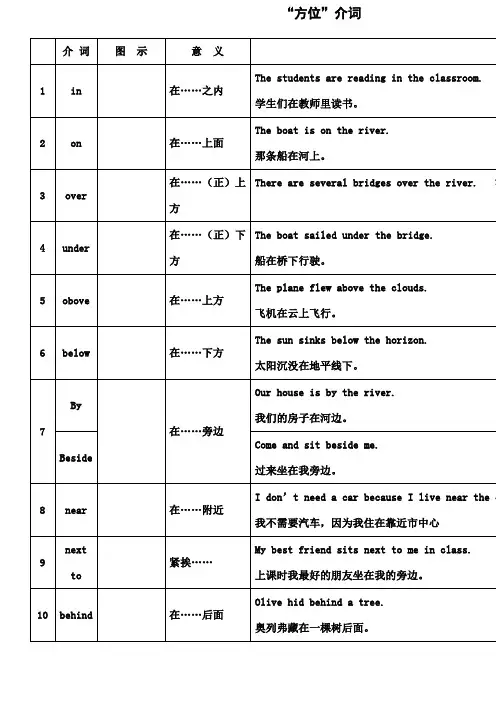
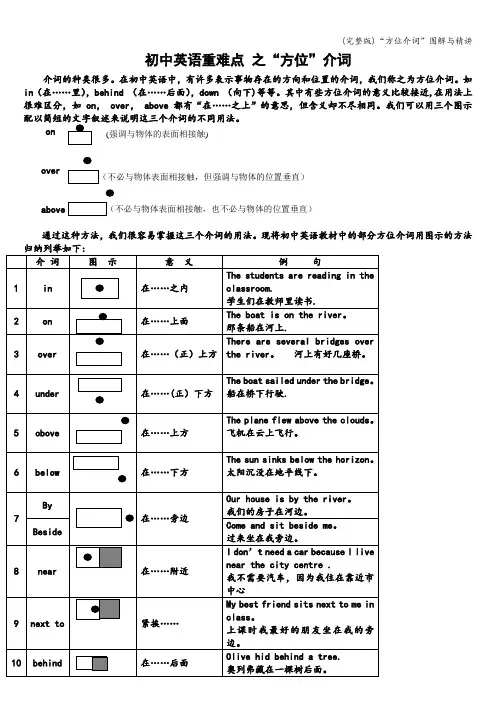
初中英语重难点 之“方位”介词介词的种类很多。
在初中英语中,有许多表示事物存在的方向和位置的介词,我们称之为方位介词。
如in (在……里),behind (在……后面),down (向下)等等。
其中有些方位介词的意义比较接近,在用法上很难区分,如on , over , above 都有“在……之上”的意思,但含义却不尽相同。
我们可以用三个图示onabove 通过这种方法,我们很容易掌握这三个介词的用法。
现将初中英语教材中的部分方位介词用图示的方法(强调与物体的表面相接触)几组方位介词的区别方位介词in, on, to的区别:1.in表示"在……范围内”,还表示“在…之中”Chongqing lies in the southwest of China。
2.on表示“与……毗邻,接壤”Canada lies on the north of America.3.to表示方位,不接壤Hunan lies to the east of Zhejiang.表示地点位置的介词:1.at, in, on, toat 用于小地方,at school, at homeIn 用于大地方, in Beijing, in ChinaOn在……上面, on the map, on the tableTo到…… To Chongqing2.Above, over, onAbove在……上方(高过另一个物体,不强调垂直)The airplane flies above that tall building.(不在正上方)over在……上方(垂直上方)The bridge spans over the river。
On在……上面(物体表面有接触)There's some water on the floor, so you should be careful。
3.Below, under在……下面Under在……下(正下方)The cat lies under the chair.(正下方)Below在……下(不一定是正下方)The cat lies under the chair.(不是正下方)4.in front of, in the front of 在……的前面in front of 在外部的前面,两个东西是独立的,相反的是behind The building is in front of the hospital.The building is behind the hospital.In the front of在内部的前面,属于其中的一部分,相反的是at the back of The girl stands in the front of the classroom.The girl stands at the back of the classroom。
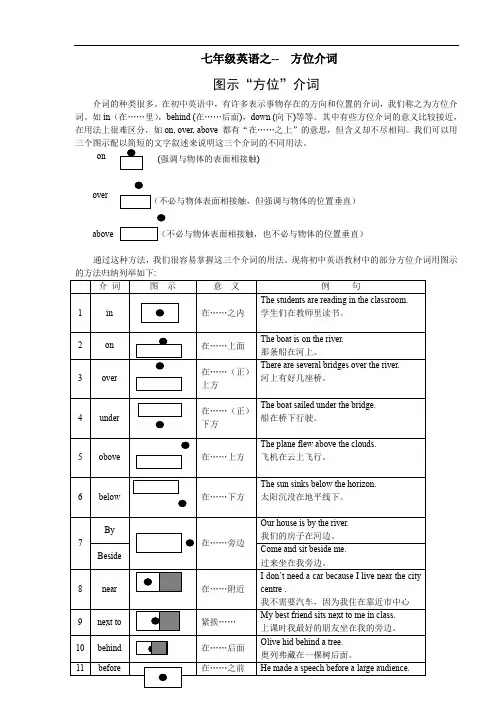
七年级英语之-- 方位介词图示“方位”介词介词的种类很多。
在初中英语中,有许多表示事物存在的方向和位置的介词,我们称之为方位介词。
如in(在……里),behind (在……后面),down (向下)等等。
其中有些方位介词的意义比较接近,在用法上很难区分,如on, over, above 都有“在……之上”的意思,但含义却不尽相同。
我们可以用三个图示配以简短的文字叙述来说明这三个介词的不同用法。
on overabove通过这种方法,我们很容易掌握这三个介词的用法。
现将初中英语教材中的部分方位介词用图示(强调与物体的表面相接触)资料赠送以下资料考试知识点技巧大全一、考试中途应饮葡萄糖水大脑是记忆的场所,脑中有数亿个神经细胞在不停地进行着繁重的活动,大脑细胞活动需要大量能量。
科学研究证实,虽然大脑的重量只占人体重量的2%-3%,但大脑消耗的能量却占食物所产生的总能量的20%,它的能量来源靠葡萄糖氧化过程产生。
据医学文献记载,一个健康的青少年学生30分钟用脑,血糖浓度在120毫克/100毫升,大脑反应快,记忆力强;90分钟用脑,血糖浓度降至80毫克/100毫升,大脑功能尚正常;连续120分钟用脑,血糖浓度降至60毫克/100毫升,大脑反应迟钝,思维能力较差。
我们中考、高考每一科考试时间都在2小时或2小时以上且用脑强度大,这样可引起低血糖并造成大脑疲劳,从而影响大脑的正常发挥,对考试成绩产生重大影响。
因此建议考生,在用脑60分钟时,开始补饮25%浓度的葡萄糖水100毫升左右,为一个高效果的考试加油。
二、考场记忆“短路”怎么办呢?对于考生来说,掌握有效的应试技巧比再做题突击更为有效。
1.草稿纸也要逐题顺序写草稿要整洁,草稿纸使用要便于检查。
不要在一大张纸上乱写乱画,东写一些,西写一些。
打草稿也要像解题一样,一题一题顺着序号往下写。
最好在草稿纸题号前注上符号,以确定检查侧重点。
为了便于做完试卷后的复查,草稿纸一般可以折成4-8块的小方格,标注题号以便核查,保留清晰的分析和计算过程。
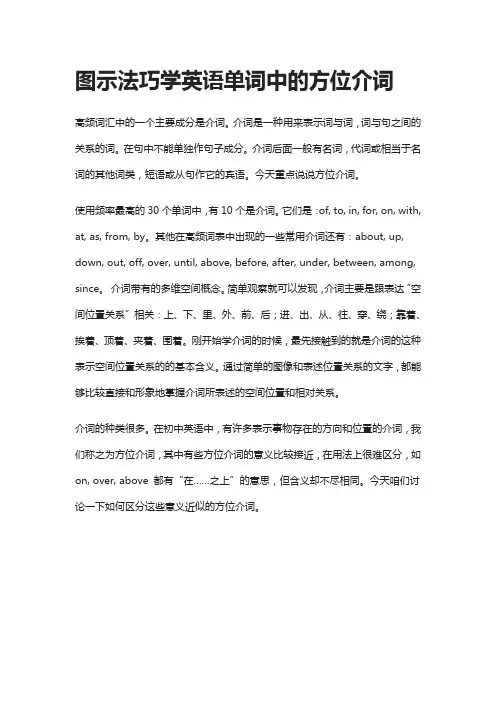
图示法巧学英语单词中的方位介词
高频词汇中的一个主要成分是介词。
介词是一种用来表示词与词,词与句之间的关系的词。
在句中不能单独作句子成分。
介词后面一般有名词,代词或相当于名词的其他词类,短语或从句作它的宾语。
今天重点说说方位介词。
使用频率最高的30个单词中,有10个是介词。
它们是:of, to, in, for, on, with, at, as, from, by。
其他在高频词表中出现的一些常用介词还有:about, up, down, out, off, over, until, above, before, after, under, between, among, since。
介词带有的多维空间概念。
简单观察就可以发现,介词主要是跟表达“空间位置关系”相关:上、下、里、外、前、后;进、出、从、往、穿、绕;靠着、挨着、顶着、夹着、围着。
刚开始学介词的时候,最先接触到的就是介词的这种表示空间位置关系的的基本含义。
通过简单的图像和表述位置关系的文字,都能够比较直接和形象地掌握介词所表述的空间位置和相对关系。
介词的种类很多。
在初中英语中,有许多表示事物存在的方向和位置的介词,我们称之为方位介词,其中有些方位介词的意义比较接近,在用法上很难区分,如on, over, above 都有“在……之上”的意思,但含义却不尽相同。
今天咱们讨论一下如何区分这些意义近似的方位介词。
对于方位介词,比较好的区别方法就是图示法。
通过简单的图片来形象地区别其意义的不同。
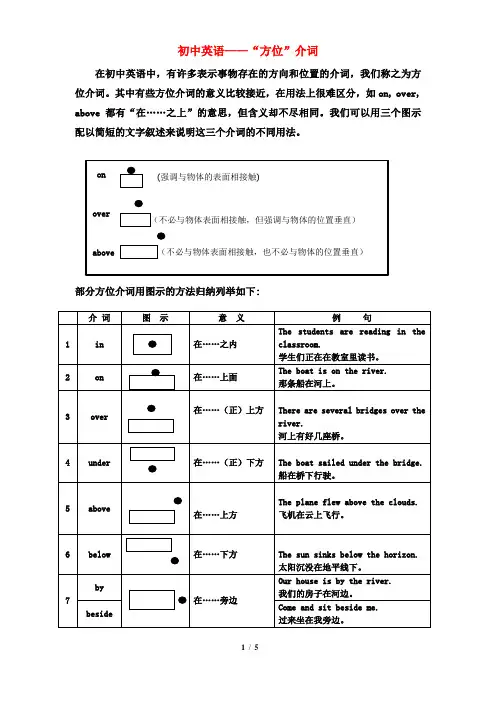
初中英语——“方位”介词在初中英语中,有许多表示事物存在的方向和位置的介词,我们称之为方位介词。
其中有些方位介词的意义比较接近,在用法上很难区分,如on, over, above 都有“在……之上”的意思,但含义却不尽相同。
我们可以用三个图示配以简短的文字叙述来说明这三个介词的不同用法。
部分方位介词用图示的方法归纳列举如下:◆几组方位介词的区别A. 方位介词in, on, to的区别:in表示“在……范围内”,还表示“在…之中” Chongqing lies in the southwest of China.✓on表示“与……毗邻,接壤”Canada lies on the north of America.✓to表示方位,不接壤Hunan lies to the east of Zhejiang.B. 表示地点位置的介词(at, in, on, to)✓at 用于小地方,at school, at home✓in 用于大地方,in Beijing, in China✓on在……上面,on the map, on the table✓to到……to ChongqingC. above, over, on✓above在……上方(高过另一个物体,不强调垂直)✓over在……上方(垂直上方)✓on在……上面(物体表面有接触)D. below, under✓under在……下(正下方)The cat lies under the chair.(正下方)✓below在……下(不一定是正下方)The cat lies under the chair.(不是正下方)E. in front of, in the front of 在……的前面✓in front of 在外部的前面,两个东西是独立的——相反的是behind✓in the front of在内部的前面,属于其中的一部分——相反的是at the back ofF. beside, near, by✓beside在旁边✓near在附近✓by在附近,非常靠近G. between, among✓between 在……之间(指两者)✓among(指三者或三者以上)●常见方位介词短语由介词in构成的方位介词短语1、in the front 在前面2、in the front row 在前排3、in the back row 在后排4、in the third row 在第三排5、in front of... 在...前面(范围之外)6、in the front of... 在...前部(范围之内)7、in the middle在中间8、in the street在街上9、in the middle of...在中间10、in the tree在树上(指飞鸟等外来物)由介词at构成的方位介词短语1、at the front of...在...所在范围的前一部分2、at the back of...在...所在范围的后一部分3、at the foot of...在...脚下4、at the top of...在...顶部5、at the end of...在...尽头(尾部)6、at the head of...在...前头7、at the(school)gate在(校)门口8、at the station 在车站9、at No.2 Chang’an Road在长安路2号10、at my uncle’s 在我叔叔家11、at home在家12、at the doctor’s在医务室/在诊所由介词on构成的方位介词短语1、on the right/left在右(左)边2、on one’s right/left在某人的右(左)边3、on the desk/table在课桌/桌上4、on the right-hand/left-hand side在右/左手边5、on the blackboard在黑板上6、on/in the wall在墙上/里7、on the paper在纸上8、on the tree在树上(指树上长的,结的东西) 其它介词构成的方位介词短语1、next to靠近/贴近2、beside the desk在课桌旁3、behind the door在门后4、under the bed在床下5、near the window靠近窗户6、outside the gate在门外。
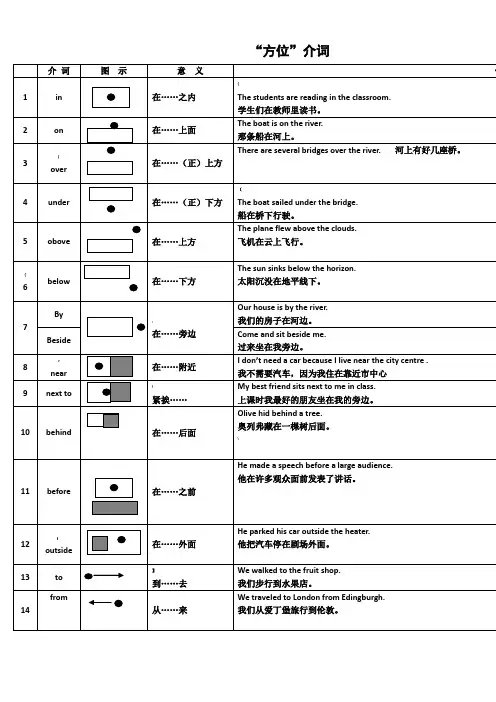
【英语】趣说图解方位介词方位介词是介词比较重要的一个分类。
利用图片记忆方位介词,能帮助学生加深印象,考试时更容易唤醒大脑的深层记忆。
现在就开始记忆吧!1. inin 表示小范围在一个大范围的里面,表示“在某范围之内”,强调两者的包含关系。
如:•Beijing is in the north of China.北京在中国的北部。
2. onon 表示一个范围紧挨着另一个范围,表示“两地接壤”,强调两者为相邻关系;还表示“在……上”,并与之相接触。
如:•Korea is on the northeast of China.朝鲜在中国的东北面。
•He put the computer on the desk.他把电脑放在桌子上。
3. toto 表示一个范围和另一个范围之间隔段距离,表示“在某范围之外”,强调两者是远离关系。
如:•Japan is to the east of China.日本位于中国的东边。
4. atat 表示在某地点,强调在某个位置点。
如:•I met Mary at the school gate this morning.我今天早上在校门口遇见了玛丽。
5. under 和 belowunder表示“在……的正下方”,指垂直上下。
below表示“在……的下方”,只表示位置低于,但不是在正下方。
如:•There is a cat under the table.桌子下面有一只猫。
•He saw many hills and rivers below the plane.他看见飞机的下方有许多小山和河流。
6. over 和 aboveover表示“在……垂直的上方”,与under相对;above表示“在……的上方”,指高于某物,但不是正上方,与below相对。
如:•She is holding an umbrella over her head.她撑着一把伞遮头。
•An airplane flew above the clouds.一架飞机在云端上面飞行。
小学英语趣说图解方位介词方位介词是介词比较重要的一个分类。
利用图片记忆方位介词,能帮助学生加深印象,考试时更容易唤醒大脑的深层记忆。
现在就开始记忆吧!1. inin 表示小范围在一个大范围的里面,表示“在某范围之内”,强调两者的包含关系。
如:Beijing is in the north of China.北京在中国的北部。
2. onon 表示一个范围紧挨着另一个范围,表示“两地接壤”,强调两者为相邻关系;还表示“在……上”,并与之相接触。
如:Korea is on the northeast of China.朝鲜在中国的东北面。
He put the computer on the desk.他把电脑放在桌子上。
3. toto 表示一个范围和另一个范围之间隔段距离,表示“在某范围之外”,强调两者是远离关系。
如:Japan is to the east of China.日本位于中国的东边。
4. atat 表示在某地点,强调在某个位置点。
如:I met Mary at the school gate this morning.我今天早上在校门口遇见了玛丽。
5. under 和 belowunder表示“在……的正下方”,指垂直上下。
below表示“在……的下方”,只表示位置低于,但不是在正下方。
如:There is a cat under the table.桌子下面有一只猫。
He saw many hills and rivers below the plane.他看见飞机的下方有许多小山和河流。
6. over 和 aboveover表示“在……垂直的上方”,与under相对;above表示“在……的上方”,指高于某物,但不是正上方,与below相对。
如:She is holding an umbrella over her head. 她撑着一把伞遮头。
An airplane flew above the clouds.一架飞机在云端上面飞行。
“方位”介词
介词的种类很多。
有许多表示事物存在的方向和位置的介词,
我们称之为方位介词。
如
in (在 ... 里),behind (在 ...... 后面),down (向下)等等。
其中有些方位介词的意义比较接
近,在用法上很难区分,如
on, over, above 都有"在 ......... 之上”的意思,但含义却不尽相
同。
我们可以用三个图示配以简短的文字叙述来说明这三个介词的不同用法。
通过这种方法,我们很容易掌握这三个介词的用法。
现将部分方位介词用图示的方法归
介词
图示
意 义
例 句
The stude nts
are readi ng in the
1
in
在••… •之内
classroom.
学生们在教师里读书。
_ ft_
在••… •上面
The boat is on the
river.
2
on
那条船在河上。
•
There are several bridges over the
在••…
(正)
3
over
river.
上方
河上有好几座桥。
4
un der
. _ A ___
在••… (正)
The boat sailed un der the bridge.
over
above
(强调与物体的表面相接触)
(不必与物体表面相接触,但强调与物体的位置垂直)
(不必与物体表面相接触,也不必与物体的位置垂直)
练习:看图写句子请参考例句:Where is the sofa?
It is in the livi ng.
参考单词:
living room 客厅;bathroom 浴室;kitchen 厨房;microwave oven 微波炉;oven 烤箱;
bedroom 卧室;attic阁楼/顶楼;television 电视机;sofa沙发;table桌子;desk书桌; teapot 茶壶;chair 椅子;fridge 冰箱;wardrobe 衣柜;drawer 扌由屉;lamp 灯; curtains 窗帘;bathtub 浴室;sink洗脸池;toilet马桶;dressing table 梳妆台;pillow 枕头;blanket 毛毯/绒被;bed 床;mirror 镜子;vase 花瓶;doll 洋娃娃;slippers 拖鞋;alarm
clock闹钟;photo 照片。